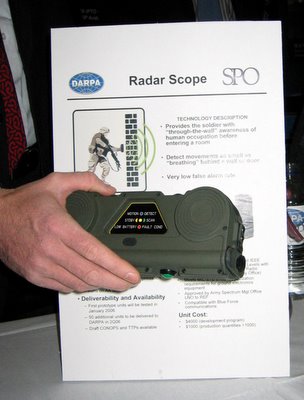 Military Sensor Hears Through Walls: : Mon Jan 9, 2006
Military Sensor Hears Through Walls: : Mon Jan 9, 2006By Bill Christensen
Technovelgy.com
A new handheld radar scope from the Defense Advanced Research Projects Agency (DARPA) can provide troops with an ability that was formerly the province of science fictional superheroes alone—the ability to sense through up to 12 inches of concrete whether someone is in the next room.
The Radar Scope is expected to be in use in Iraq by spring of this year, according to DARPA's Edward Baranoski. Weighing just 1.5 pounds, the device is about the size of a telephone handset and will cost about $1,000. Waterproof and rugged, it runs on AA batteries. Held up to a wall, users will be able to sense movements as small as breathing up to fifty feet into the next room.
"It may not change how four-man stacks go into a room (during clearing operations)," Baranoski said. "But as they go into a building, it can help them prioritize what rooms they go into. It will give them an extra degree of knowledge so they know if someone is inside." (From DefenseLink)
Science fiction writers have been working on this idea for generations. Golden age writer E.E. "Doc" Smith wrote about a spy ray in his 1934 novel Triplanetary. DARPA has yet to actually come up with an actual sci-fi life detector like the one that Frank Herbert wrote about in 1958 in his story Cease Fire:
The antennae of the Life Detector atop the OP swept back and forth in a rythmic halfcircle like so many frozen sticks brittle with rime ice...
One operator - drugged to shivering wakefulness - stood watch in the OP. The space around him was barely six feet in diameter, crammed with equipment, gridded screens glowing a pale green with spots that indicated living flesh. (Read more about Frank Herbert's life detector)
Still, the handheld Radar Scope is a remarkable invention, and should make the task of searching buildings at least a bit less dangerous. Read more at DefenseLink.
(This Science Fiction in the News story used with permission from Technovelgy.com - where science meets fiction.)
Military Mulls Use of 'Star Trek' Weapons
The Military's Walrus: An Unlikely Flying Machine
http://news.yahoo.com/s/space/20060109/sc_space/militarysensorhearsthroughwalls
++++++++++++++++++++++++++++++++++++++++
US Air Force Takes a Look at Teleportation: posted: 03 November 2004
http://www.livescience.com/scienceoffiction/technovel_teleport_041103.html
By Bill Christensen
It seems that mere stealth technology is not enough; the United States Air Force wants to get from here to there without even traversing the space in between. Are they looking for a Star Trek(TM) transporter? Or maybe even a farcaster from science fiction writer Dan Simmons' awesome novel Hyperion, which lets you step from one planet to the next?
Not quite: but, lest you think that our friends at DARPA are the only ones interested in science-fictional possibilities, the USAF recently took delivery of a new study regarding the military potential of teleportation.
The Teleportation Physics Study was done by Eric Davis of Warp Drive Metrics. Its purpose -
http://www.fas.org/sgp/eprint/teleport.pdf
"This study was tasked with the purpose of collecting information describing the teleportation of material objects, providing a description of teleportation as it occurs in physics, its theoretical and experimental status, and a projection of potential applications. The study also consisted of a search for teleportation phenomena occurring naturally or under laboratory conditions that can be assembled into a model describing the conditions required to accomplish the transfer of objects."
The author broke down the various possibilities in this way:
Teleportation – SciFi: the disembodied transport of persons or inanimate objects across space by advanced (futuristic) technological means (adapted from Vaidman, 2001). We will call this sf-
Teleportation, which will not be considered further in this study.
Teleportation – psychic: the conveyance of persons or inanimate objects by psychic means. We will call this p-Teleportation.
Teleportation – engineering the vacuum or spacetime metric: the conveyance of persons or inanimate objects across space by altering the properties of the spacetime vacuum, or by altering the spacetime metric (geometry). We will call this vm-Teleportation.
Teleportation – quantum entanglement: the disembodied transport of the quantum state of a system and its correlations across space to another system, where system refers to any single or collective particles of matter or energy such as baryons (protons, neutrons, etc.), leptons (electrons, etc.), photons, atoms, ions, etc. We will call this q-Teleportation.
Teleportation – exotic: the conveyance of persons or inanimate objects by transport through extra space dimensions or parallel universes. We will call this e-Teleportation.
Even though I was disappointed with the outright dismissal of Star Trek-style teleportation (sheesh!), I was briefly encouraged by the fact that he offered solutions that meet the definition of vm-teleportation:
"The first solution can be found from the class of traversable wormholes giving rise to what I call a true “stargate.” A stargate is essentially a wormhole with a flat-face shape for the throat as opposed to the spherical-shaped throat of the Morris and Thorne traversable wormhole, which was derived from a spherically symmetric Lorentzian spacetime metric that prescribes the wormhole geometry."
Unfortunately, despite a lot of very impressive math, he seems to settle on p-teleportation as the most likely recommendation for further study, saying
"P-Teleportation, if verified, would represent a phenomenon that could offer potential high-payoff military, intelligence and commercial applications. This phenomenon could generate a dramatic revolution in technology, which would result from a dramatic paradigm shift in science. Anomalies are the key to all paradigm shifts!"
I know what you're thinking; more wasted government money. However, a quick look at the distribution list thoughtfully included at the end of the report shows that a copy was sent to Gregory Benford, physicist and highly respected sf author. Maybe we'll get a good story out of it.
In the meantime, read what it would be like to step through a wormhole; check out Frank Herbert's description of a vortal tube from his 1969 novel Whipping Star.
(This Science Fiction in the News story used with permission from Technovelgy.com - where science meets fiction.)
+++++++++++++++++++++++++++
Military Tests Miniature Spy Plane
Visit LiveScience.com for more daily news, views and scientific inquiry with an original, provocative point of view. LiveScience reports amazing, real world breakthroughs, made simple and stimulating for people on the go. Check out our collection of Amazing Images, Image Galleries, Interactive Features, Trivia and more. Get cool gadgets at the new LiveScience Store, sign up for our free daily email newsletter and check out our RSS feeds today!
+++++++++++++++++++++++++++++++++++++
New Device Will Sense Through Concrete Walls
http://www.defenselink.mil/news/Jan2006/20060103_3822.html
By Donna Miles
American Forces Press Service
WASHINGTON, Jan. 3, 2006 – Troops conducting urban operations soon will have the capabilities of superheroes, being able to sense through 12 inches of concrete to determine if someone is inside a building.
The new "Radar Scope" will give warfighters searching a building the ability to tell within seconds if someone is in the next room, Edward Baranoski from the Defense Advanced Research Projects Agency's Special Projects Office, told the American Forces Press Service.
By simply holding the portable, handheld device up to a wall, users will be able to detect movements as small as breathing, he said.
The Radar Scope, developed by DARPA, is expected to be fielded to troops in Iraq as soon as this spring, Baranoski said. The device is likely to be fielded to the squad level, for use by troops going door to door in search of terrorists.
The Radar Scope will give warfighters the capability to sense through a foot of concrete and 50 feet beyond that into a room, Baranoski explained.
It will bring to the fight what larger, commercially available motion detectors couldn't, he said. Weighing just a pound and a half, the Radar Scope will be about the size of a telephone handset and cost just about $1,000, making it light enough for a soldier to carry and inexpensive enough to be fielded widely.
The Radar Scope will be waterproof and rugged, and will run on AA batteries, he said.
"It may not change how four-man stacks go into a room (during clearing operations)," Baranoski said. "But as they go into a building, it can help them prioritize what rooms they go into. It will give them an extra degree of knowledge so they know if someone is inside."
Even as the organization hurries to get the devices to combat forces, DARPA already is laying groundwork for bigger plans that build on this technology.
Proposals are expected this week for the new "Visi Building" technology that's more than a motion detector. It will actually "see" through multiple walls, penetrating entire buildings to show floor plans, locations of occupants and placement of materials such as weapons caches, Baranoski said.
"It will give (troops) a lot of opportunity to stake out buildings and really see inside," he said. "It will go a long way in extending their surveillance capabilities."
The device is expected to take several years to develop. Ultimately, servicemembers will be able to use it simply by driving or flying by the structure under surveillance, Baranoski said.
Radar Scope Link:
http://www.defenselink.mil/news/Jan2006/20060103135226_radar_scope-20060103.jpg
Defense Advanced Research Projects Agency expects the portable Radar Scope to look similar to this model and to be fielded as soon as this spring to help patrols conducting urban operations to sense if someone is inside a building. Photo by Donna Miles (Click photo for screen-resolution image);high-resolution image available.
Related Site:
Defense Advanced Research Projects Agency
http://www.darpa.mil/
The Defense Advanced Research Projects Agency (DARPA)
is the central research and development organization for the Department of Defense (DoD). It manages and directs selected basic and applied research and development projects for DoD, and pursues research and technology where risk and payoff are both very high and where success may provide dramatic advances for traditional military roles and missions.
+++++++++++++++++++++++++++++++++++++++++++++++++++++
Relevant Links:
The Defense Advanced Research Projects Agency (DARPA)
http://www.darpa.mil/
DARPA is the central research and development organization for the Department of Defense (DoD). It manages and directs selected basic and applied research and development projects for DoD, and pursues research and technology where risk and payoff are both very high and where success may provide dramatic advances for traditional military roles and missions.
Click ~@ website ~for directory of DARPA Technical Staff
Please Select the DARPA staff member(s) you wish to contact:
The True* Origin of the InterNet
http://www.clueless.com/
Internet ~ Origin of the Internet, Part 1
http://library.thinkquest.org/C0116084/IO1.htm
Internet ~ Origin of the Internet, Part 2
http://library.thinkquest.org/C0116084/IO2.htm
++++++++++++++++++++++++++++++++++++++
Comment: All high-tech or low-tech tools and weapons, including the Internet, have the potential for good and the capacity for evil. Humanity should utilizes its tools and weapons wisely and humanely. ~Peta de Aztlan
++++++++++++++++++++++++++++++++++++++++

No comments:
Post a Comment